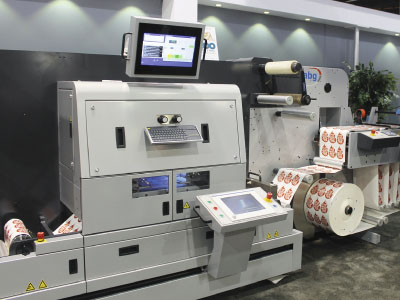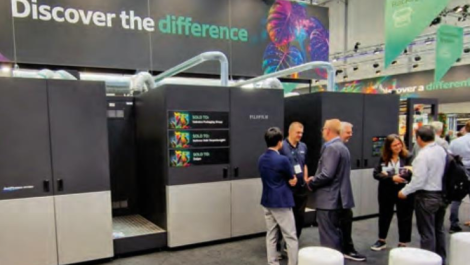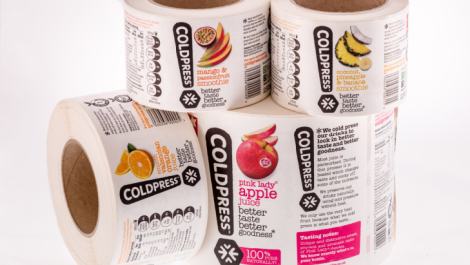ABG Digicon converter with Digilase module
The agility offered by cutting labels using a laser is well suited to digital printing technology. Neel Madsen speaks to a handful of manufacturers about the advantages and potential issues of laser cutting.
Digital label printing, with its shorter runs and fast turnaround times, has changed the demands on finishing equipment. Each label can be different in terms of colour and design, so it is only natural to expect the same from the shape, but cutting with a solid or semi-rotary flexible die does not offer this option. Enter the laser with its flexibility to cut each label to a different shape and even to a different cutting depth.
The synergy between digital printing and laser cutting offers a smooth and much faster workflow. William Dinauer, president of LasX Industries, said, ‘Being digital in nature, laser cutting is highly compatible with digital print. The ability to create the print and laser files in the same artwork file streamlines the workflow processes.’
‘Companies that have invested in digital printing equipment have done so due to the need to provide short job turnaround times and unlimited printing possibilities for their customers,’ said Mike Bacon, VP of sales and marketing at Spartanics. ‘Laser cutting provides immediate job turnaround and unlimited cutting possibilities at no additional cost. Many customers are still able to charge set-up fees that go directly to the bottom line of any label job.’
There are also a number of cost savings. ‘The benefits of using a laser are numerous,’ said ABG’s laser business development manager Floriana Montella. ‘There is no need to keep a wide library of conventional dies, tying up limited resources, such as money and space.’
‘Laser technology has come a long way, and new advancements are taking place every day,’ said David Grenwis, marketing coordinator at Delta ModTech. ‘The laser’s claim to fame is that it can cut through intricate, tricky patterns that would be difficult for a traditional rotary die-cutter.’ He continued, ‘It is also a prototype friendly technology with a quick turnaround. Laser cutting doesn’t require hard tooling, so it’s ideal if you want to create quick prototype. You can then invest in a more durable rotary cut die down the road for long runs.’
The latest developments in laser cutting can be seen particularly in the software that drives the modules and integrates them with the workflow in label production. Here as in most other sectors, automation and digitisation is the name of the game.
Automation
ABG International has been developing laser technology for 16 years and at last year’s Labelexpo showcased the new Digilase workflow solution. ‘We have developed software that in conjunction with an MIS compiles the artwork automatically into a laser file that is optimised for the die shape. Each job’s cutting/slitting criteria is downloaded directly onto the machine and sets up the back scorer and slitting knives automatically,’ explained Ms Montella.
She continued, ‘Our Complier software package is unique. Not only because it can be modified/upgraded by our engineers to meet each customer’s specific needs, but also for its functionality, which allows a completely automatic workflow changeover. The software processes a job in advance, so when the printed web enters the laser cutter, the job barcode has already been read and the laser is prepared for that individual job, minimising set-up time.
‘The software controls every single step of every job printed on the same roll and automatically adjusts the register and the settings at each job changeover.’
Grafisk Maskinfabrik (GM) has many years of experience with laser cutters. It has supplied both cutting, marking and engraving applications for the self-adhesive market, passport production and advanced OPV organic solar cells.
The company’s main product is the DC330Hybrid combination finishing line with laser and conventional semi-rotary die-cutter in one machine, as well as a low cost entry solution, the LC330 Laser Compact 330.
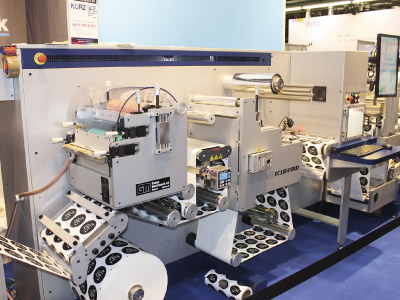
GM’s DC330Hybrid combination finishing line with laser and conventional semi-rotary die-cutter
CEO Uffe Nielsen said, ‘GM launched a fully automated solution at Labelexpo 2016. We will continue this trend and develop solutions for fully automated lines with cloud connectivity and integration towards existing digital print solutions like the Xeikon front end. We are also looking into offering more economic versions of the LC330 for entry solutions.’
GM too has developed a full automation suite of software to support the workflow between the press and the laser converting unit. Mr Nielsen explained, ‘As an example, it is possible to stack up a full roll of jobs and then convert them in one go with out stopping the laser. Another example is to run the laser inline with the digital press and change job on the fly.’
Integration
Delta ModTech has been integrating lasers into converting systems for over 15 years, most recently under the Edge Laser Technology brand. It offers the Edge, a modular laser system mounted onto the Crusader rotary converting platform, and the Flex Edge, which is a standalone system, which can run roll to roll, sheetfed or inline with another converting machine. The company also provides custom laser cutting systems that are designed for specific process and production demands.
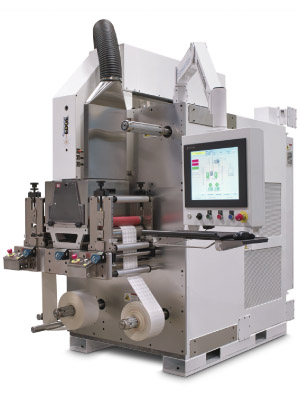
The Flex Edge from Delta ModTech can run roll to roll, sheetfed or inline
David Grenwis said, ‘Recently we’ve integrated barcode readers to load new cut profiles to the laser on the fly. This allows for pattern changes without stopping to load a new program mid roll and shortening changeover time.’
LasX Industries was founded in 1998 to deliver laser digital cutting solutions to the manufacturing industry. In 2015, the company expanded operations into Europe by opening a sales, service and integration engineering facility in Germany. Its primary product is the LaserSharp Processing Module (LPM), which can be integrated into automated material handling systems in roll, sheet or part format.
With a LasX solution, the laser system exists as a node on the network and the file is dropped into a hot folder where it is automatically prepared to run via the RIP. This workflow simplifies the process and prepares the file for the automation finishing process. William Dinauer said, ‘Generally, the graphics department works with a tool, such as Adobe Illustrator (AI), to produce artwork, differentiate layers and edit each layer of a file accordingly, which is a powerful advantage when using the same software. By exporting the file to a PDF, the file can serve both the printer and the laser.’
The system employs a barcode, which is used to register the laser cut via a camera reading, and each print repeat is registered. This means that every label or part from the first to the last is cut accurately and there is no waste in trying to dial in the die register. The barcode is placed at every repeat or the lead edge of the sheet.
Spartanics offers the SR350, a standard semi-rotary die-cutting system, which has been designed to allow customers to add a laser module at any point in the future. Mike Bacon said, ‘Spartanics continues to be a leader with our L350 Laser Cutting Machine, which is strictly used for customers that require converting options and laser cutting. Our SRL350 includes both semi-rotary and laser cutting, along with other converting options.’ For companies that require part extraction, the L350 roll to part machine integrates an extraction device into the laser cutting line to extract parts from a web of material.
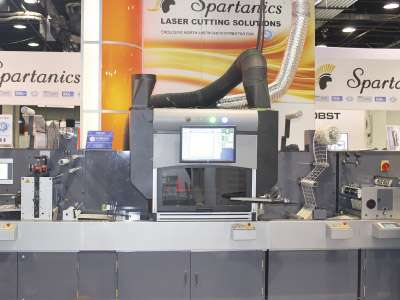
Laser cutting on the Spartanics stand at Labelexpo 2016
‘Most laser cutting software works with PDF files that are typically used when generating a digital printing RIP. A designer selects the die line by simply clicking the die layer within the AI file. For example, a laser cut file is extracted through the laser cutting software. Some laser cutting systems can be integrated to work with the RIP software so additional file set-up steps are eliminated,’ he said.
Potential issues
There are a few known issues that users need to be aware of, such as white edges, adhesive bleed and scoring. This is dependent on the type of substrate used, and while a laser can cut very intricate patterns, the difficulty of the die line will affect the speed.
‘Substrates are a challenge,’ said Mr Nielsen. ‘Even with new 10.2 nm lasers that are optimised for PP, there is some melting edge. PVC and PE are difficult to cut as well. Problems of discolouration on cut to edge were more pronounced in the past, but can now be managed via the right material choice. Finally cutting on laminated substrates still presents a challenge,’ he added.
Mr Grenwis said, ‘Lasers may struggle with more difficult materials, and it is best to have the material laser tested for cutting feasibility. A rotary die usually cuts through any substrate at approximately the same speed, but the laser speed will be dependent on the cut pattern.’ He added, ‘Rotary die is better for handling big production runs, as it can cut at a faster rate and ultimately a lower cost.’
A traditional rotary die will compress the edge of the label and offer a clean cut. The ‘white edge’ is often mentioned as a problem for laser cutting. Mr Dinauer commented, ‘A common issue with laser converting of labels are with full-bleed printed labels as the laser will leave a white, visible edge due to the angle in processing the outside edge and the interaction of the laser with the ink.’ He explained that as a workaround, there are methods that remove the label from the liner and cut it from the back, and then reapply it to the liner. However, he recommended that concerns of the adhesive near the edge of the laser labels being damaged must be tested before implementing this alternative to the problem.
The future
Fully automated set ups, faster processing speeds and new applications are driving laser cutting into the future. Uffe Nielsen said that GM is seeing a growing demand in fully automated set ups – so called ‘Industry 4.0’ solutions – and that there is also a steady flow of request for solutions for ultra short-run applications. Delta ModTech’s Dave Grenwis said that the increased speeds of the new large format digital printers will push laser manufacturers to increase the laser processing speeds.
‘Synchronisation with digital print is an area of growth, as short run needs will continue to be in demand and push new market segments,’ said LasX president, William Dinauer. He also pointed to flexible packaging as a key area growth area, as lasers provide a major advantage in providing consumer convenience features in packaging.
He concluded, ‘Printers and converters need to diversify to survive long-term by making investments that will give them the ability to expand into other markets such as industrial, electronics, medical, textile and more. Laser processing solutions are a viable solution in expanding market potential, especially with the advantage of integration with digital printing equipment and automation technologies such as robots to sort and stack sheeted products.’

